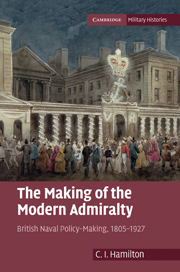Book contents
- Frontmatter
- Contents
- List of tables
- Preface
- Introduction
- 1 Lord Barham's Admiralty: 1805
- 2 Admiralty reform, 1806–1835
- 3 Decision-making at the Admiralty, c. 1806–1830
- 4 Admiralty administration and decision-making, c. 1830–1868. The Graham Admiralty
- 5 The Admiralty reformed again: context and problems, 1868–1885
- 6 Administrative and policy-making responses, c. 1882 onwards
- 7 Fisher and Churchill, and their successors, 1902–1917
- 8 The Naval Staff, planning and policy
- 9 Lord Beatty's Admiralty
- Conclusion
- Appendix 1 First Lords, First Sea Lords and Permanent Secretaries, 1805–1927
- Appendix 2 Acronyms and definitions
- Manuscript sources and select bibliography
- Index
7 - Fisher and Churchill, and their successors, 1902–1917
Published online by Cambridge University Press: 03 May 2011
- Frontmatter
- Contents
- List of tables
- Preface
- Introduction
- 1 Lord Barham's Admiralty: 1805
- 2 Admiralty reform, 1806–1835
- 3 Decision-making at the Admiralty, c. 1806–1830
- 4 Admiralty administration and decision-making, c. 1830–1868. The Graham Admiralty
- 5 The Admiralty reformed again: context and problems, 1868–1885
- 6 Administrative and policy-making responses, c. 1882 onwards
- 7 Fisher and Churchill, and their successors, 1902–1917
- 8 The Naval Staff, planning and policy
- 9 Lord Beatty's Admiralty
- Conclusion
- Appendix 1 First Lords, First Sea Lords and Permanent Secretaries, 1805–1927
- Appendix 2 Acronyms and definitions
- Manuscript sources and select bibliography
- Index
Summary
Fisher and the Admiralty
John Fisher – Sir John Fisher from 1884, Lord Fisher from 1909 – did not so much go to the Admiralty as keep on coming back. He first served there as Director of Naval Ordnance (1886–91), then as Controller and Third Naval Lord (1892–7), as Second Naval Lord (1902–3), and First Sea Lord (1904–10), returning to the latter office in 1914. After a sudden desertion of his post in May 1915, and a suicidal attempt to dictate to the Prime Minister the terms of his return, he was still given an Admiralty foothold as chairman of the Board of Invention and Research. There was even at first a chance of his returning to the Board of Admiralty in some subordinate capacity, though that was lost in March 1916 in part because of an ill-managed campaign by his friends and supporters. Subsequently, though he could never quite bring himself to accept it, his time of power had passed. Nevertheless, his achievement was a remarkable one. For nearly thirty years, he had been involved in the crucial naval questions of the day, often helped shape them, and at times dominated the final decisions. One mark of his influence had been the limited effect of his occasional absences from Whitehall. Whether he was Admiral Superintendent at Portsmouth, or Commander-in-Chief in North American waters or in the Mediterranean, he still remained in touch with what was going on in London, and despatched his tables of the law (‘letters’ is an inadequate term) to friends, allies, supporters and followers, helping shape their thought on naval matters, thus preparing the way for his return to Whitehall when he could again take up the reins into his own hands.
- Type
- Chapter
- Information
- The Making of the Modern AdmiraltyBritish Naval Policy-Making, 1805–1927, pp. 213 - 241Publisher: Cambridge University PressPrint publication year: 2011

